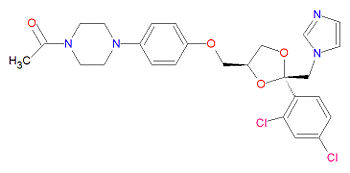Ketoconazole
Jump to navigation
Jump to search
Ketoconazole is one of the azole-based antifungal drugs used to treat fungal infections. Its use has greatly diminished because of the introduction of better treatment alternatives, including the triazoles fluconazole and itraconazole.
Mechanism of action
Azole-based antifungal agents, such as ketoconazole, work by inhibiting the enzyme cytochrome P450 14--demethylase (P45014DM), which is part of the sterol biosynthesis pathway that converts lanosterol to ergosterol. Because ketoconazole has less affinity towards fungal cell membranes than the newer triazole antifungal agents like fluconazole and itraconazole, it is more likely to bind with mammalian cell membranes and induce toxicity.

